Top 850 Power Supplies for Performance Enthusiasts
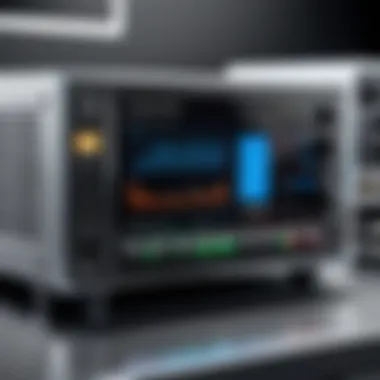
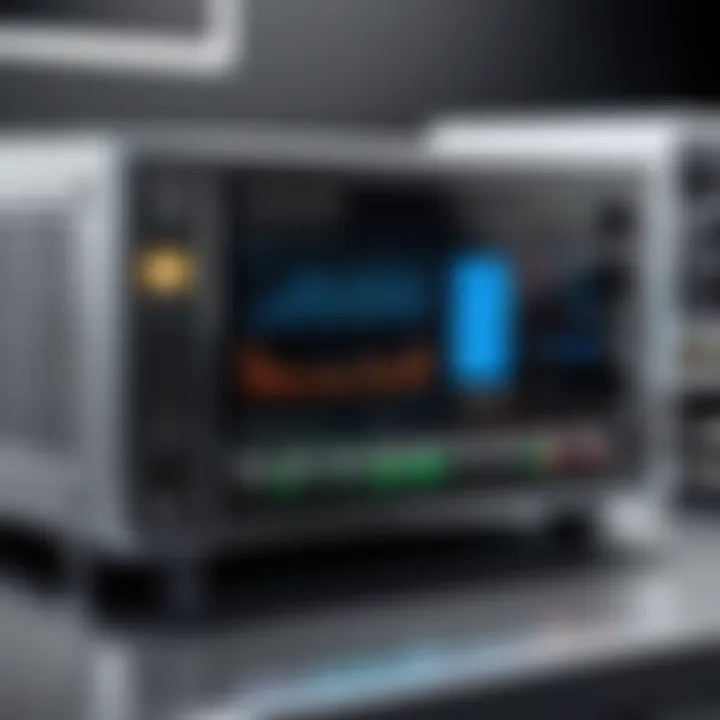
Intro
In the realm of high-performance computing, the power supply unit (PSU) often remains an underappreciated component. However, for gamers, IT professionals, and tech enthusiasts alike, selecting the right power supply is pivotal. This article takes a detailed look at the best 850 power supplies currently available on the market. We will explore critical factors that influence the quality and performance of these units, ensuring that the reader can make an informed decision when faced with a multitude of options.
Key considerations include efficiency ratings, modular designs, and specific features that cater to advanced user needs. By dissecting these elements, we hope to clarify the advantages and limitations of various PSUs. Ultimately, this guide is designed to enhance your understanding and assist in choosing the optimal power supply for your distinct requirements.
Preface to Power Supplies
Power supplies are crucial components in any electronic setup. They convert alternating current (AC) from the outlet into direct current (DC) needed for internal components. A well-chosen power supply unit (PSU) ensures stability, reliability and performance. This is vital for high-performance systems that operate demanding hardware, like powerful GPUs and CPUs.
Selecting the right PSU is not just about matching wattage. It involves understanding efficiency, connectors, and compatibility with other components. As technology evolves, power demands can increase, making it essential to evaluate your needs.
Definition and Functionality
A power supply unit is an electronic device that provides power to various components in a system. It takes power from a wall outlet and converts it into usable power for the computer or related system. The main functions of a PSU include:
- Conversion: Changing AC to DC power.
- Regulation: Maintaining a consistent voltage level.
- Protection: Preventing damage from voltage spikes and other anomalies.
Power supplies are categorized by their output wattage, with 850 watts being a popular choice for high-performance scenarios. This is because it strikes a balance between delivering enough power for demanding tasks and being efficient.
Importance of Selecting the Right PSU
Choosing the suitable PSU can greatly impact your system’s performance and longevity. A wrong choice could lead to various issues:
- Instability: Inadequate power can cause system crashes or hardware failure.
- Inefficiency: Over/under-specifying a PSU can lead to increased energy costs and waste.
- Future-Proofing: A good PSU can support upgrades, negating the need for future replacements.
When deciding on a PSU, consider factors such as total power capacity, modularity, and efficiency certification. The right PSU not only powers your components but also affects overall system performance. Ensuring that it is compatible with your hardware can prevent many potential issues that may arise from poor power delivery or insufficient supply.
Understanding Wattage and Power Supplies
Understanding wattage is crucial for anyone looking to invest in a power supply unit, particularly a high-performance 850 watt unit. Wattage, in simple terms, refers to the total power output the PSU can efficiently handle. This section examines the significance of wattage and why selecting 850 watts is a prevalent choice among technology enthusiasts, gamers, and IT professionals.
What Does Watts Mean?
When referring to 850 watts in a power supply, it denotes the maximum power that the unit can deliver to its components. This specification is critical as it determines how well a system can perform under heavy load conditions. An 850 watt power supply supports a range of components, including processors, graphics cards, and other peripherals. The amount of power required depends on the hardware configuration, as more powerful components often demand more electricity.
For instance, a high-end gaming computer with an advanced graphics card may require close to 750 watts or more under load. An 850 watt power supply provides a buffer, ensuring that the system runs efficiently without straining the PSU. It also allows for future upgrades, catering to evolving hardware demands.
Why Choose an Watt Power Supply?
Opting for an 850 watt power supply comes with several notable advantages:
- Headroom for Upgrades: An 850 watt PSU offers flexibility for future upgrades. As technology evolves, upgrades can occur without the need to replace the power supply.
- Efficiency and Stability: Power supplies operate more efficiently when they run at around 50-80% of their total capacity. With an 850 watt unit, typical usage might sit comfortably within this range, promoting stability.
- Support for Multi-GPU Setups: For enthusiasts using multiple graphics cards, an 850 watt power supply provides essential power to support demanding configurations, ensuring games and applications run smoothly.
- Longer Lifespan: A PSU that operates comfortably within its wattage limit tends to have a longer lifespan. It experiences less heat generation and stress, which can prolong its operational life.
Key Components of a Power Supply Unit
Understanding the key components of a power supply unit is essential for high-performance computing needs. The PSU is not just a simple device that converts electrical power. It balances various factors to ensure optimal performance of connected hardware components. Each part within the power supply contributes significantly to reliability, efficiency, and overall functionality.
Transistors and Capacitors
Transistors and capacitors are critical components within a PSU. Transistors act as switches or amplifiers for electrical signals, playing a key role in converting electrical energy. Power supplies typically use a series of transistors to manage the flow of electricity from the input to the output. They transform high-voltage input into usable low-voltage outputs suitable for computer hardware.
Capacitors, on the other hand, store electrical energy temporarily. They help smooth out fluctuations in voltage and maintain a steady output. This is vital for sensitive components such as GPUs and CPUs. Without capacitors, power supplies would struggle to provide stable and consistent power, leading to potential component damage or system instability.
Some benefits of high-quality transistors and capacitors include:
- Improved Efficiency: Quality components can contribute to higher efficiency ratings.
- Stable Output: They ensure that the output voltage remains stable under different loads.
- Enhanced Longevity: Better components typically lead to a longer life span of the PSU.
- Lower Noise: Higher-quality transistors and capacitors can yield quieter operations.
Power Connectors
Power connectors are the interfaces that supply energy to various components in a computer system. Each connector type serves a particular component, ensuring that the right voltage and current are supplied without risk of damage. The common connectors include the ATX main connector, CPU power connectors, and PCIe connectors for graphics cards.
The role of each connector is:
- ATX Main Connector: Connects the PSU directly to the motherboard, distributing power to various components.
- CPU Power Connectors: Specifically supply power to the processor.
- PCIe Connectors: Deliver power needed for high-performance graphics cards.
Choosing a PSU with the correct connectors is crucial for compatibility and performance. Having the right number of connectors and ensuring they fit properly will reduce the risk of power complications. The importance of quality should not be overlooked; connectors must securely fit to prevent power loss and maintain system stability.
"The key to a successful build is not just in choosing powerful components but ensuring they receive stable and sufficient power through quality PSUs and connectors."
A detailed understanding of these key components provides vital insights into the reliability and efficiency of the entire power supply unit. For tech enthusiasts and professionals, this knowledge will ultimately guide informed purchasing decisions.
Efficiency Ratings Explained


The efficiency of a power supply unit (PSU) is a pivotal factor, especially when considering performance and operational costs. Understanding efficiency ratings is essential for anyone looking to optimize their high-performance setup. The efficiency of a PSU impacts both its ability to supply power effectively and its environmental footprint. Higher efficiency means less energy waste, which translates into lower energy bills and reduced impact on power consumption. This section will break down the significance of efficiency ratings, particularly focusing on the 80 PLUS certification, a standard that many users rely on.
Understanding PLUS Certification
The 80 PLUS certification is a widely recognized efficiency standard that classifies power supplies based on their energy performance at different loads. To attain this certification, a power supply must operate at 80% efficiency at 20% and 100% of its rated load, and at least 82% efficiency at 50% load. The program includes various levels, such as Bronze, Silver, Gold, Platinum, and Titanium, each representing incrementally higher efficiency percentages. Here are the key categories:
- 80 PLUS Bronze: 82% efficiency at 50% load.
- 80 PLUS Silver: 85% efficiency at 50% load.
- 80 PLUS Gold: 87% efficiency at 50% load.
- 80 PLUS Platinum: 90% efficiency at 50% load.
- 80 PLUS Titanium: 92% efficiency at 50% load.
This classification allows consumers to make informed choices regarding which power supplies to invest in, ensuring they select a unit that aligns with their performance expectations and sustainability goals.
Impact on Performance and Energy Costs
Efficiency ratings have a significant bearing on performance and energy costs. A high-efficiency power supply not only wastes less energy as heat but also ensures delivery of stable and consistent power to the components within a system. This stability is crucial, as fluctuations can lead to hardware failure over time.
The financial implications of choosing a more efficient PSU can be substantial, particularly in long-term use. Consider a scenario where a less efficient 850-watt unit is used:
- Less Efficient Power Supply: May operate at 80% efficiency, leading to a 20% energy loss.
- More Efficient Power Supply (e.g., Titanium rated): Operates at 92% efficiency, reducing energy loss to 8% only.
Using a power supply with a higher efficiency rating means lower operating costs, particularly relevant for users who run demanding systems continuously, such as servers or high-performance gaming rigs.
Additionally, a reliable PSU with good efficiency ratings contributes to a cooler system, potentially extending the lifespan of components. Over time, this prevents unnecessary replacements and can enhance overall system performance.
Modular vs Non-Modular Power Supplies
Understanding the differences between modular and non-modular power supplies is critical when selecting a good PSU. Each design has its benefits and suitable applications. This distinction will help you to make a more informed decision based on your particular needs.
Benefits of Modular Design
Modular power supplies allow users to connect only the cables that are necessary for the setup. This feature greatly reduces clutter inside the PC case. A neat environment promotes better airflow and easier management. Additionally, modular designs often come with improved cable quality, leading to better performance and reliability. Another significant advantage is the ease of installation. Users can customize their cable connections according to specific needs, making upgrades or repairs simpler. The flexibility in cabling can be a benefit especially for high-performance systems where every detail matters.
Key benefits of modular PSUs include:
- Improved airflow: Less clutter means better cooling potential.
- Easier installations: Quick and hassle-free setups.
- Customization options: Tailor the cable connections according to your needs.
- Future availability: As you upgrade your system, adjust connections without re-cabling everything.
When Non-Modular Is Sufficient
Non-modular power supplies still hold an important place in the market. While they do come with all cables permanently attached, this design can be quite advantageous in certain scenarios. For budget-constrained builds, non-modular units are generally less expensive. This can be a decisive factor for gamers or tech enthusiasts who want solid performance without breaking the bank.
Additionally, non-modular power supplies can be easier for first-time builders as they often come in simpler designs with fewer choices to make during installation. They offer reliability and functionality without the complexities of modular options.
In some cases, users might not have high customization needs. If you use a standard set of components that does not require bespoke connection types, then a non-modular PSU can meet those requirements with effectiveness.
Factors favoring non-modular PSUs are:
- Cost-effectiveness: Generally cheaper than modular counterparts.
- Simplicity: Fewer components to manage.
- Reliability: Many established non-modular options perform excellently.
- Sufficient for standard setups: Good enough for basic PC builds.
Top Watt Power Supplies on the Market
The selection of an 850 watt power supply unit (PSU) is critical for anyone seeking reliable performance. These power supplies cater to both high-end gaming rigs and demanding workstations. Understanding what distinguishes each model on the market assists users in making informed decisions. High-performance needs require specific considerations, including efficiency ratings, modular design options, and the ability to support complex systems.
Choosing the right 850 watt PSU provides several important benefits:
- Stable Power Delivery: A good power supply ensures consistent voltage output, protecting sensitive components against damage from power surges.
- Efficiency: Efficient power supplies reduce electricity costs over time and contribute to lower heat production, promoting a cooler environment.
- Future Compatibility: An adequately rated power supply allows users to upgrade hardware without worrying about power limitations.
The following subsections will explore three leading 850 watt models that stand out in terms of specifications, performance, and design features.
Model A: Specifications and Performance
Model A offers impressive specifications suited for both gamers and professionals. It is characterized by an output rating of 850 watts with a peak efficiency of up to 90%. The unit incorporates a 120mm fan, which operates silently while maintaining optimal cooling.
Key specifications include:
- Form Factor: ATX
- Efficiency Certificate: 80 PLUS Platinum
- Rail Configurations: Single +12V rail
- Dimensions: 160mm x 150mm x 86mm
Performance tests have shown that Model A maintains stable voltage output under load. Users have praised its reliability during extensive gaming sessions and heavy computational tasks.
Model B: Overview and Review
Model B stands out for its robust design and durability. It follows a semi-modular approach, allowing users to connect only the cables they need. This feature enhances airflow inside the case and simplifies cable management.
User reviews often highlight:
- Silent Operation: The fan operates only under heavy load to minimize noise.
- Warranty: Offering a comprehensive 10-year warranty assures customers of its longevity.
- Safety Features: It includes over-voltage, under-voltage, and short-circuit protection.
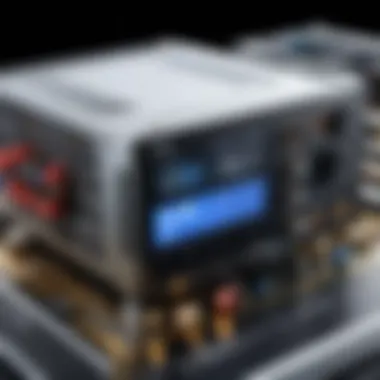
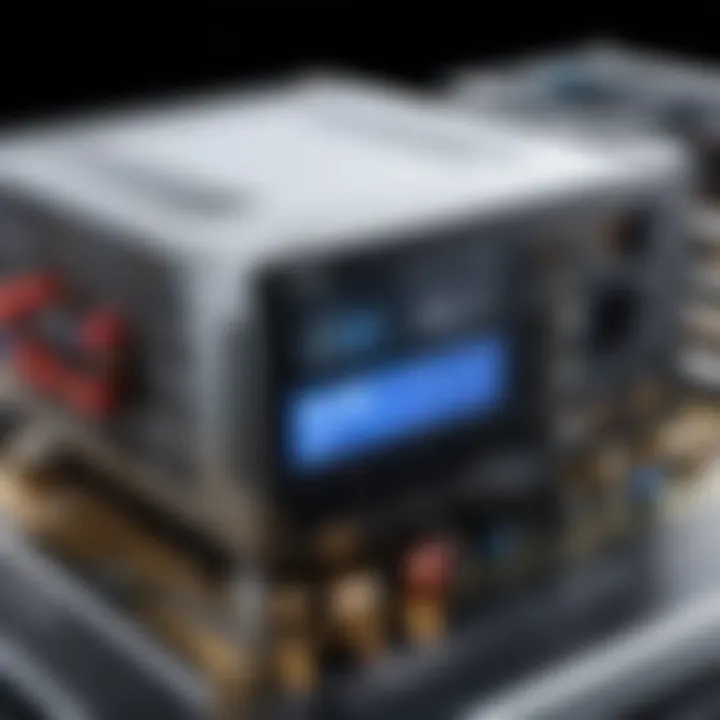
Overall, Model B strikes a balance between performance and user convenience, making it a solid choice in the 850 watt category.
Model C: Key Features
Model C is another top contender in the marketplace. It distinguishes itself with a fully modular design, which allows complete customization of cable connections. This model not only enhances aesthetics but also promotes better airflow.
Noteworthy features include:
- 100% Japanese Capacitors: For improved reliability and heat resilience.
- RGB Lighting: Offers customizable lighting options to match any build theme.
- Compact Design: At just 140mm in length, it fits into most cases easily.
For users focused on build aesthetics along with high performance, Model C represents a combination of functionality and style.
"Selecting the right power supply impacts your entire build. It is not just about wattage but about reliable performance over time."
Each of these models offers unique characteristics suitable for different types of users. As you continue through the buying process, consider each unit's features against your specific needs.
Comparative Analysis of Top Models
In any serious pursuit of technology, especially when it relates to power supplies, understanding and analyzing various models becomes essential. The section serves this purpose by highlighting crucial elements that set apart one power supply from another. This analysis is vital for readers looking to invest in a power supply that maximizes performance while staying mindful of costs, efficiency, and features.
A structured comparison provides insights into how different models perform under similar conditions. Readers can make informed choices based on specs—such as output quality and reliability—rather than being swayed by marketing hype. Furthermore, it facilitates an understanding of which specific requirements or setups each model suits best, enabling users to tailor their choices to individual needs.
This section aims to break down two key areas: performance metrics and price versus performance ratio. Both these aspects will allow a clearer picture of a model’s practical value.
Performance Metrics Comparison
Performance metrics encompass various factors, including voltage regulation, noise levels, and efficiency under different loads. These metrics provide a comprehensive evaluation of how well a power supply operates in real-world scenarios.
For instance, one critical metric is load regulation, which indicates how much the voltage output varies as the power supply changes load. High-performance PSUs typically exhibit minimal variation, ensuring stable power delivery which is particularly important during peak loads, such as gaming or intense computational tasks.
Noise is another important factor. Power supply units produce a certain amount of acoustic noise generated primarily by their fan systems. A top-rated unit effectively balances performance with sound, ensuring users are not distracted during use.
Overall, reliability under strain plays an integral role here, particularly for power users. Factors such as temperature resilience and longevity also come into play. Models frequently subjected to heavy loads should ideally have enhanced cooling systems and components designed for durability. Evaluating these factors equips the reader with the ability to recognize which models excel in tough conditions.
Price Versus Performance
When analyzing power supplies, the price versus performance aspect cannot be ignored. Users often find themselves grappling with the dilemma of whether to invest in higher-priced units that promise better efficiency and features. A thorough examination can clarify this matter.
A valuable approach is to assess the cost per watt of each model. This metric helps determine whether the added features justify the additional expense. For example, an 850-watt power supply that offers excellent modular support and is 80 PLUS Gold certified may come at a premium but could save users money on electricity bills in the long run.
By presenting a range of options across varying price points but maintaining a consistent focus on performance, users can gauge what suits their budget while delivering the desired capability. This also encourages an awareness of potential trade-offs; sometimes, a lower-cost model may be sufficient for light use, while heavier users may derive more value from high-end models.
Ultimately, this comparative analysis guides readers through the labyrinth of choices that exist when selecting a power supply, arming them with the knowledge needed to make well-grounded decisions that reflect their specific power needs.
User Considerations When Choosing a PSU
Choosing the right power supply unit (PSU) is fundamental for optimal performance and reliability. When considering an 850 watt PSU, several user-centric factors come into play. Understanding these elements can enhance your overall computer experience. This section focuses on the most critical user considerations: component compatibility and future-proofing your setup.
Compatibility with Components
Compatibility is paramount when selecting a PSU. If your PSU does not align with your components, it can compromise performance or even cause damage. Here are some essential points to consider:
- Connector Types: Modern motherboards and graphics cards require specific power connectors. Ensure the PSU provides the necessary 24-pin ATX, 8-pin CPU, and PCIe connectors for your hardware.
- Power Requirements: Different components demand varying wattages. Adding high-performance graphics cards or multiple drives will increase overall power needs. Verify that the PSU meets or exceeds the requirements of all components, leaving some margin for peak loads.
- Form Factor: Ensure the PSU fits within your case. Some models are larger than standard sizes. Check the dimensions before purchasing.
Failure to address these compatibility factors can lead to installation issues or, worse yet, system instability. Making sure your PSU can adequately power your system will avoid complications down the road.
Future-Proofing Your Setup
Future-proofing is often overlooked but crucial for a long-term investment. Technology evolves quickly, and your current setup might not satisfy future demands. Here are several considerations to help you future-proof your PSU choice:
- Higher Wattage Capability: Opting for a PSU rated at 850 watts allows headroom for upgrades. If you plan to expand your system in the future, having extra capacity can save you from changing your PSU too soon.
- Efficiency Ratings: Power supplies with higher efficiency ratings, such as 80 PLUS Gold or Platinum, provide better performance and lower energy bills. This efficiency will become important as components become more power-hungry.
- Modular Design Options: A modular PSU design offers flexibility. As you upgrade components, having the ability to add or remove cables without clutter can simplify future modifications.
In summary, considering compatibility and future-proofing plays an essential role in selecting an 850 watt PSU. Ensuring your PSU meets present requirements while allowing room for expansions makes it a wise choice for any user.
Installation and Setup Guidelines
Proper installation of an 850 watt power supply is vital for ensuring system stability and component longevity. A well-executed setup minimizes risks associated with electrical connections and facilitates optimal performance. This section will discuss key elements, benefits, and considerations that users should keep in mind during the installation process.
Safety Precautions
Safety is paramount when working with power supplies. Before beginning installation, users should observe the following precautions:
- Power Down Your System: Always turn off the power supply at the switch. Unplug the power cord from the socket to eliminate any electrical hazards.
- Ground Yourself: Use an anti-static wrist strap or touch a grounded metal object. This reduces the risk of electrostatic discharge damaging sensitive components.
- Keep Workspace Clean: Ensure the area is free from clutter and conductive materials. This prevents accidental damage during installation.
- Read the Manual: Familiarize yourself with the specific power supply and motherboard instructions. Each product may have slightly different requirements.
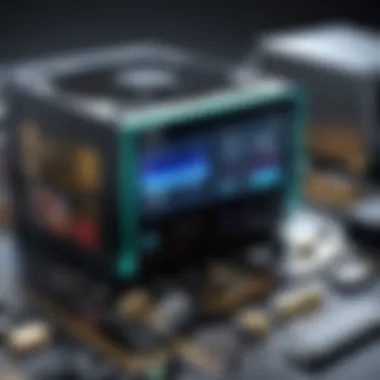

"A safe installation process is as important as selecting the right PSU. Always prioritize safety first."
Steps for Proper Installation
Installing your power supply involves several specific steps to guarantee everything functions correctly. Follow these guidelines for effective setup:
- Prepare Your Case: Before installing the power supply, ensure you have adequate space within your computer chassis. Remove any obstacles that might hinder the installation process.
- Position the Power Supply: Align the power supply unit within the case, ensuring that the fan side is positioned correctly (either facing outwards or downwards, based on the case design).
- Secure the Power Supply: Use the screws provided to fasten the PSU in place. Ensure it is tightly connected to avoid vibrations and movement.
- Connect Power Cables: Start connecting the main power cables from the PSU to the motherboard. This typically includes the 24-pin ATX and the 4/8-pin CPU connectors. Make sure these connections are secure.
- Attach Peripheral and GPU Cables: Depending on the components you are using, you'll need to connect additional cables to GPUs, hard drives, and cooling fans. It’s wise to plan cable management ahead, avoiding clutter.
- Check Connections and Tidy Up: Once all cables are connected, double-check for any loose connections. Organize cabling to improve airflow within the case. This is especially important for cooling efficiency.
- Final Setup: After ensuring everything is properly installed and organized, plug the power supply back into the wall outlet but do not turn it on yet. Wait until you have verified other components' placement in the case.
By following these guidelines, users can effectively harness the capabilities of their 850 watt power supplies. Each step promotes a reliable and efficient system ensuring all components perform at their peak.
Common Issues and Troubleshooting
When dealing with power supplies, understanding common issues and troubleshooting methods is essential. A power supply unit (PSU) is vital for the function of your system. Knowing how to identify and resolve problems can prevent prolonged downtime and protect your components.
Recognizing Signs of Failure
Recognizing signs of failure in a power supply is critical. Early detection can save components from damage caused by an unstable power source. Look for the following indicators of PSU issues:
- Unexpected Shutdowns: If your system shuts down without warning, this may indicate that the PSU is failing to deliver sufficient power.
- Inconsistent Power: Systems that experience freezing or random reboots may be receiving inconsistent power levels.
- Burning Smell: A noticeable burning odor is a strong sign that something is wrong within the PSU.
- Expansion of Capacitors: Visual inspections may reveal bulging or leaking capacitors, a common sign of PSU failure.
It is advisable to monitor the PSU's indicators and track any unusual behavior in the system. This diligent observation can help diagnose issues before they escalate.
Solutions to Frequent Problems
After identifying possible issues with a PSU, knowing how to resolve them is invaluable. Here are some common problems and their solutions:
- Sudden Shutdowns: Check the power connections. Ensure cables are properly seated. If the problem persists, it may be worth testing the system with a different PSU to rule out hardware failures.
- Overheating: Ensure adequate ventilation in your case. Clean any dust that may be obstructing airflow and consider a PSU with better cooling mechanisms.
- No Power: Verify that the PSU is turned on and its cables are connected securely. If there is still no response, the PSU may need replacement.
- Voltage Irregularities: Use a multimeter to check voltage levels. Inconsistent readings may point to a faulty PSU, requiring professional evaluation.
Understanding common PSU issues and their solutions is crucial for maintaining system integrity and longevity.
By familiarizing yourself with potential signs of failure and knowing effective solutions, you can ensure optimal performance and reliability of your high-performance setup.
Environmental Considerations
The topic of environmental considerations is vital when discussing power supply units, especially for high-performance uses like gaming or IT applications. The shift towards more sustainable technology has made it important to assess how power supplies impact energy consumption and waste. As users become more aware of their ecological footprint, the selection of an appropriate PSU involves not just performance metrics but also environmental implications.
Energy Efficiency Impact
Energy efficiency in power supplies directly correlates to the environmental consequences of their usage. High-efficiency power supplies convert more of the input energy into usable output with minimal losses. This efficiency is often represented through the 80 PLUS certification. Higher ratings, like Platinum or Titanium, imply that the device wastes less electricity as heat. Consequently, not only does this mean reduced energy bills for the consumer, but it also signifies lower overall electricity demand from power plants. This can lead to a decreased carbon footprint, which is increasingly crucial in our energy-driven world.
Moreover, more efficient power supplies generate less heat, leading to a cooler operating environment. This reduced heat output can lessen the need for additional cooling solutions in computing systems, further saving energy. By selecting an 850 watt power supply that boasts high efficiency, users contribute to an overall reduction in energy consumption and thus, the broader impact on global energy policies and endeavors to combat climate change.
Recycling and Disposal of PSUs
As technology advances, the lifecycle of hardware components like power supplies comes under scrutiny. The recycling and proper disposal of power supplies are critical aspects to consider due to the valuable materials and potential hazards they carry. Power supplies can contain heavy metals and substances that are detrimental to the environment if not handled correctly.
Many manufacturers are now working to create power supplies that are easier to recycle, thus helping consumers play a role in sustainability. Users should familiarize themselves with local regulations regarding electronic waste. For example, many localities have designated e-waste recycling centers that can provide safe disposal of old or unused power supplies.
The recycling process can recover precious resources like copper, aluminum, and rare earth elements. These materials can be reused to produce new components, effectively lessening the need for new raw material extraction. Additionally, manufacturers are increasingly focusing on designing products that are not only high-performance but also environmentally friendly.
Closure and Recommendations
The conclusion of any discussion on power supplies, particularly regarding the best 850-watt options available, serves multiple important purposes. This section synthesizes the key points discussed throughout the article and reinforces the significance of making informed decisions. For tech enthusiasts, gamers, and IT professionals, the choice of power supply can impact system stability and performance. Thus, it is essential to weigh all factors when evaluating PSUs.
Technological advancements are ongoing, and the PSU landscape is constantly evolving with new models, features, and efficiency ratings. Therefore, a well-rounded understanding of particular brands and their product lines cannot be underestimated. Choosing the right 850-watt PSU should consider not only the immediate needs but also future-proofing aspects for potential upgrades.
In our analysis, we have highlighted notable attributes that contribute to a superior power supply unit, such as:
- Efficiency Ratings: Understanding the importance of 80 PLUS certifications and how they reflect performance and energy savings.
- Modular Designs: Assessing the trade-offs between modular and non-modular PSUs.
- Performance Metrics: Comparing specifications such as stability, output voltage quality, and thermal management.
- User Compatibility: Ensuring the PSU fits well within the existing hardware, offering enough connectors and compatibility.
In our recommendations, consider brands known for their reliability and customer service. Always review user feedback as it provides invaluable insights into real-world use. Prioritize efficiency and expandability while also keeping budgetary limitations in mind.
"A solid power supply is the heart of any high-performance system. It is more than just a component; it is the lifeblood that ensures smooth operation."
Take these factors into account while making your final decision. Thoughtful choices will yield a long-term benefit, enhancing both performance and user experience.
Final Thoughts on Choosing the Best PSU
Choosing the best 850 PSU should be perceived not merely as a purchase, but as an investment in the overall system performance and reliability. Consider your specific use case and ensure that the PSU fits your configuration. The longevity of your hardware can often depend on the quality of the power supply. Therefore, prioritize features that might initially seem superfluous, such as enhanced cooling solutions or robust protection mechanisms, as these can mitigate risks associated with system failures.
Ultimately, a well-researched decision will serve to prevent complications and ensure optimal efficiency, which is especially crucial for demanding applications like gaming or intensive computational tasks.
Resources for Further Research
To enhance your understanding and keep abreast of developments in power supplies, here are some helpful resources:
These platforms will offer diverse perspectives, recommendations, and the latest news in the technology realm. Engaging with these communities can provide deeper insights and assist you in navigating the intricate landscape of high-performance power supplies.







